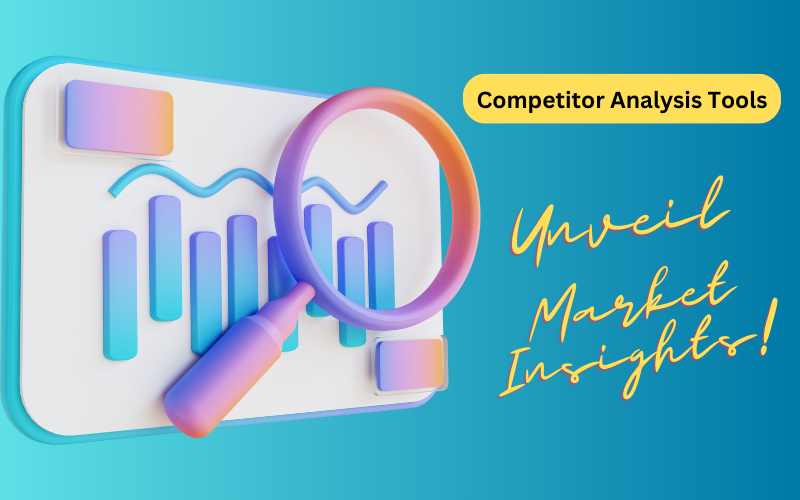Competitor analysis tools help businesses decipher their rivals’ strategies. They streamline market research by providing insights into competitors’ performance.
In the ever-evolving world of business, staying ahead of the competition is crucial. Competitor analysis tools are instrumental in unlocking the secrets of successful strategies used by market leaders. They allow companies to identify strengths and weaknesses in their own strategies as well as track the moves of their competitors.
With features like tracking keywords, analyzing website traffic, and monitoring social engagement, these tools offer a window into the competition’s operations. By leveraging this data, businesses can make informed decisions to refine their marketing efforts, improve their products, and better position themselves in the market. This not only aids in shaping a company’s tactical approach but also helps to anticipate market shifts based on others’ actions. Whether you’re a startup or an established player, employing these tools effectively can be a game-changer in your industry.
Competitor Analysis Tools: The Business Battlefield
In the digital arena, businesses fiercely compete for online dominance. Knowledge is power on this battlefield. Competitor analysis tools provide critical intel. They reveal enemy tactics, strengths, and weaknesses. Winning requires this power.
Why Every Business Needs Espionage
Business isn’t just about what you do. It’s about knowing what others are doing. Competitor analysis tools are your secret agents. They gather data on competitors. This data shapes your strategies.
- Track competitors’ website traffic
- Analyze backlinks for SEO strategies
- Monitor market trends and adapt quickly
These insights help companies make smart moves. They educate businesses on where to strike and where to improve.
The Strategic Value Of Knowing Your Rivals
Understanding your opponent is key to victory. These tools unveil competitive secrets. Strategic advantages arise when you understand:

Knowledge affects decisions. From pricing to product development, it guides you to outmaneuver competitors. It also helps prevent market share loss, ensuring business growth.
Key Features Of Top Competitor Analysis Tools
Understanding competitors is crucial for online success. Top competitor analysis tools offer features that provide valuable insights. These features help businesses to adapt strategies, improve offerings, and stream better results. We will now look at the key features that set the best tools apart.
Real-time Tracking Abilities
The best competitor analysis tools provide real-time tracking. This feature allows businesses to monitor competitor activities as they happen. Benefits include:
- Instant market trend analysis
- Up-to-date competitor pricing strategies
- Immediate insights into competitors’ promotions and launches
In-depth Reporting Functions
Quality reporting functions turn data into actionable insights. Features to expect include:
- Custom reports that focus on specific metrics or goals
- Visual data representations, like charts and graphs, for easy comprehension
- Detailed performance analysis of competitors
These reports help focus efforts where they matter most.
Customizable Dashboards For Various Metrics
Customizable dashboards are key for monitoring different metrics. Users can:
- Track key performance indicators (KPIs) important to their business
- Modify views for different team members
- Highlight areas of opportunity and concern
With this adaptability, businesses can keep a pulse on specific success factors.
From Scrutiny To Strategy: Translating Data Into Actions
Imagine finding a treasure map. Competitor Analysis Tools are much like that. They offer rich insights and data about market rivals. But what’s next? The real value comes from using this information to improve your business strategies. Let’s learn how to turn this data into effective action.
Identifying Market Trends
Staying ahead in the game means knowing where the game is going. Market trends show consumer behavior and industry shifts. Analyzing these patterns helps predict future movements.
- Demand spikes for products or services
- Technological advancements shaping your industry
- Changes in consumer preferences
Use these insights to craft strategies that are one step ahead.
Spotting Emerging Competitors
Watch out for new players! Emerging competitors can disrupt the market. Competitor analysis tools offer early detection, giving you a strategic advantage. Align your strategies to outsmart these new threats.

Optimizing Your Own Marketing Tactics
Improve your strategies by learning from others. Competitor analysis tells you what works and what doesn’t. It’s a chance to refine your marketing. Here’s what to focus on:
- Unique Selling Points (USPs) that set you apart
- SEO strategies driving traffic to your rivals
- Social media patterns engaging your audience
Apply these lessons to polish your tactics, drawing more attention to your brand.
Case Studies: Success Stories Using Competitor Analysis
Have you ever wondered how some businesses soar past their competition? Smart companies use competitor analysis tools to craft strategies that lead to real success. Here, we dive into inspiring stories of businesses that harnessed the power of competitor analytics to achieve remarkable success.
Startups Outmaneuvering Goliaths
Small players often dream big. And sometimes, they win big too! With limited resources, startups have turned the tables on industry giants by being nimble and data-smart.
- Brand X spotted an untapped market segment through competitive data, resulting in a 300% sales growth in one year.
- A tech startup used analysis tools to identify growth opportunities. They capitalized on emerging trends faster than the big names, doubling their market share.
Retail Giants Staying On Top
Retail behemoths stay leading the pack by keeping a close eye on the competition. They use competitor analysis tools to tweak their strategies adeptly.
- Retail Giant A adjusted pricing in real-time by monitoring competitors, leading to a 20% boost in revenue.
- Brand Y revamped its marketing after a comprehensive competitive review, resulting in increased customer loyalty and a higher NPS score.
Navigating Legalities And Ethics In Competitive Intelligence
Understanding your market space involves observing competitor practices. It’s essential during this process to navigate the complexities of legalities and ethics in competitive intelligence. The right tools help businesses stay on the correct side of the law while ethically gathering invaluable data. Here, we’ll explore the fine line between what is legal and what’s not and maintaining ethical integrity during data acquisition.
Drawing The Line: Legal Surveillance Vs. Corporate Espionage
Legal surveillance involves observing open-source information. This includes data from public websites, press releases, or any legally accessible competitor information. Competitive intelligence tools use this data to provide insights into market trends and competitor strategies.
- Public Records: Financial documents and filings offer legal insight into a company’s performance.
- Social Media: Platforms like LinkedIn provide a wealth of knowledge on corporate activities.
- Job Listings: They may indicate a competitor’s direction or expansion.
Corporate espionage, on the other hand, involves the illegal acquisition of trade secrets or confidential information. This could include hacking, theft, or any form of unauthorized accessing of a competitor’s proprietary information.

Maintaining Ethical Integrity In Data Gathering
Gathering competitive intelligence ethically is paramount. Ethical practices ensure credibility and respect in the market. Tools that harvest data must comply with ethical standards and legal requirements. Research should always respect privacy and intellectual property rights.
- Consent: Obtain information directly from stakeholders when possible to avoid misunderstandings.
- Transparency: Be open about data-gathering practices and purposes.
- Compliance: Adhere to laws like GDPR, which regulates data protection and privacy in the European Union.
User agreements and terms of service of different platforms must be respected. Ethical tools for competitive intelligence focus on providing insights without crossing these crucial boundaries.
The Future Of Market Intelligence
The landscape of market intelligence is evolving rapidly.
Businesses must adapt to stay ahead.
New technologies pave the way for advanced competitor analysis.
Emerging Technologies Shaping Competitor Analysis
Data collection and analysis are becoming more sophisticated.
- Machine Learning automates the extraction of insights.
- Big Data allows companies to process vast amounts of information.
- Cloud Computing provides accessibility and scalability.
- The Internet of Things (IoT) offers real-time data interconnectivity.
These tools deliver a competitive edge.
Predictive Analytics And Ai In Understanding Market Dynamics
Predictive analytics and AI revolutionize market analysis.
These technologies forecast trends and behavior.

Frequently Asked Questions For Competitor Analysis Tools
What Tool Is Used For Competitor Analysis?
Several tools assist in competitor analysis, including SEMrush, Ahrefs, and SpyFu. Each offers insights into competitors’ strategies and performance.
What Are The 4 Competitor Analysis?
The four types of competitor analysis are direct, indirect, replacement, and SERP competitors. Each category represents distinct market challengers your business may face.
What Is The Best Way To Do Competitor Analysis?
Identify key competitors and analyze their online presence, including their website structure, content, SEO strategy, backlink profile, and social media activity. Use competitive analysis tools to track keywords, traffic, and market share.
What Are The 5 Steps To Analyse Your Competitor?
Identify key competitors and their online presence. Analyze their website structure and content strategy. Scrutinize their SEO tactics including keywords and backlinks. Evaluate their social media activity and engagement levels. Monitor their performance through metrics such as traffic and conversion rates.
Conclusion
Navigating the competitive landscape requires the right set of tools. This roundup of competitor analysis platforms equips you with options to stay ahead. Make informed decisions based on actionable insights these tools provide. Remember, understanding your rivals paves the way for your own strategic victories.
Choose your toolkit wisely and outsmart the competition.
Read More: Mailchimp Email Marketing in 2024: Best Pricing, Pros and Cons, ActiveCampaign vs ClickFunnels – Which is the Best Email Marketing Tool in 2024, What to Do If Your Youtube Channel is Not Growing: Skyrocket Your Views!, How Can You Apply Autonomous Vehicles in Your Everyday Life: Smart Moves!, 5 Effective Websites for Remote Jobs: Top Virtual Career Hub




